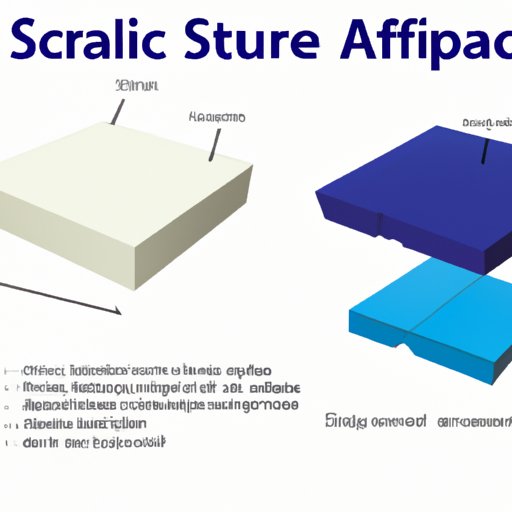
Introduction
Surface area refers to the total area of a 3D object’s exterior. This concept is essential in real-life scenarios such as construction, architecture, and chemical and physical processes. Knowing how to calculate surface area is also helpful in everyday situations, such as when you need to know how much wallpaper or fabric to use.
Step-by-Step Guide
Calculating the surface area of a 3D shape involves calculating the area of each face and adding them together. Below is a comprehensive guide on how to find the surface area of different 3D shapes:
Cubes
A cube has six faces, all of which are identical squares. To find the surface area of a cube, use the following formula:
Surface Area = 6s²
Where s is the length of one of the cube’s sides.
Rectangular Prisms
A rectangular prism has two identical bases and four rectangular faces. To find the surface area of a rectangular prism, use the following formula:
Surface Area = 2lw + 2lh + 2wh
Where l is the length, w is the width, and h is the height of the rectangular prism.
Cylinders
A cylinder has two circular bases and a curved surface. To find the surface area of a cylinder, use the following formula:
Surface Area = 2πr² + 2πrh
Where r is the radius of the circular base, and h is the height of the cylinder.
Cones
A cone has a circular base and a curved surface that tapers to a point. To find the surface area of a cone, use the following formula:
Surface Area = πr² + πrl
Where r is the radius of the circular base, and l is the slant height of the cone.
Comparing Surface Areas
It can be challenging to visualize how big or small an object’s surface area is without a reference point. Here are some everyday objects or structures and their surface areas to give you an idea of how to apply surface area calculations:
– A tennis ball has a surface area of approximately 21.1 cm²
– A refrigerator has a surface area of approximately 6.6 m²
– A high-rise building can have a surface area of several thousand square meters
Surface Area in Real-world Applications
Surface area calculations have numerous practical applications in real life. For example, architects need to know the surface area of a building’s exterior to estimate the amount of material needed for construction. Wallpaper or fabric vendors need to know the surface area of a room to determine how much of their product a customer should purchase. Scientists and engineers use surface area calculations to determine the dosage of medication required for a patient based on the medication’s surface area.
Importance in Science and Engineering
Surface area is an essential concept in many fields. In construction, surface area calculations are used to determine the amount of material required for a building project. In chemical processes, surface area affects reaction rates because increasing the surface area exposes more particles to the reaction’s environment. In physical processes such as heat transfer, surface area affects how efficiently heat is transferred to or from an object.
Common Mistakes and Tips
Here are some common mistakes people make when calculating surface area and tips on how to avoid them:
– Forgetting to include all faces: Always ensure you find the area of every face before adding them together.
– Using the wrong units: Make sure that your units are consistent throughout the calculation. For example, if you are measuring in centimeters, make sure all measurements are in centimeters.
– Misreading measurements: Double-check all measurements before plugging them into the formulas.
– Confusing radius and diameter: The radius is half the diameter, so make sure you are using the correct value in the formula.
Real-world Examples
Surface area calculations have many uses in various industries and professions. Here are some examples:
– Food packaging: The surface area of food packaging affects the shelf-life of the product. A smaller surface area helps to reduce the chances of bacterial growth and slows down the spoilage process.
– Architecture: Estimating the surface area of a building’s exterior helps architects to determine the amount of material needed for construction.
– Medicine: The surface area of a patient’s body is used to determine the optimal dosage of medication to administer. In some cases, medication is dosed based on surface area rather than weight.
– Industrial Chemistry: Surface area calculations are used to determine the efficiency of catalysts, which are used to speed up chemical reactions.
Visual Aids
To help better understand the concepts of surface area and its calculations, here are some illustrations and diagrams:
[Insert relevant illustrations and diagrams here]
Conclusion
Surface area is an essential concept that has practical applications in real life. Knowing how to calculate surface area is important in fields such as construction, architecture, and chemical and physical processes. Avoiding common mistakes and understanding surface area’s importance in various industries and professions can help you make accurate calculations. By using our step-by-step guide and real-world examples, you can become proficient in calculating surface area like a pro.




